
Most Visited
Rats In Your Home
Drain Flies
Why Drains Block
Internal Venting
Who`s Drain Is It ?
Drain Surveys
No-Dig Repairs
Drain Location
Drain Rods Stuck
Find A Contractor
Drain Pipe Work
Clay Drain Pipes
Plastic Pipe Work
Pitch Fibre Pipes
Cast Iron Pipes
Concrete Pipes
Drainage Parts
Drain Gullies
Dropshafts
Interceptor Traps
Soil Vent Pipes
Anti-Flood Valves
Manholes
Drain Repairs
Excavations
Drain Lining
Patch Lining
Pipe Bursting
Re-Rounding
Drainage
Investigations
Drain Surveys
Sonar Tracing
Last updated 1 August, 2014
draindmain.com > site map > drainage manholes
Manholes & Inspection Chambers
Building regulations as we know them now came into force on a national scale in 1966 with properties built prior to this being subject to local public health acts and local by-laws and housing acts which could vary greatly from one area to another. In London there was great debate about the use of interceptor traps in chambers in the late 19th Century and whilst one borough would insist on the form of chamber construction to be used their neighbouring borough would not necessarily insist on a chamber at all. So quite often on earlier properties whether you have an access chamber or not could be down to the original builder, then again in the 1960`s when new build housing estates were constructed with separate storm and foul systems you would often find a house occupying a corner plot having numerous chambers many of which may not actually serve the property. Buried & Hidden ChambersSo you could find yourself with numerous unsightly inspection chambers in the middle of your bowling green style lawn, or a dirty great cast iron manhole cover spoiling your patio so many manhole covers are hidden or buried. Landscapers, gardeners, flag layers and tar-mac laying gangs are all responsible for this kind of thing at one time or another however with modern inset type covers and frames it is possible to discreetly incorporate a cover into any form of hard standing or landscaping project. Covers are also lost due to the natural growth of a garden in flower beds or shrubbed areas and many extensions are constructed over drainage systems and their access points, often with dire consequences such as rat ingress into the home. Finding Buried Inspection ChambersThere are several methods for locating buried chambers they are as follows;
If however the properties are uniform but there are all manor of chambers at different locations with newer covers this would tend to indicate that the chambers have been added to the system at a later date. Most concealed covers are literally inches below the surface and often its the depth of the flag or the thickness of the tar-mac that is covering it, so if you have an idea of where the cover may be a metal detector could be an easy and relatively cheap method of locating it. Most metal detectors can be affective to a depth of 300mm so anything beyond that and you may struggle, and of course it could be a stone flag covering the chamber instead of a metal cover so you may not get a signal at all. The modern version of the metal detector is the ground penetrating radar which can be used to locate drainage runs, culverts, manholes and chambers, its a high tech bit of kit and the cost would be prohibitive for a single domestic chamber however on large site investigations its a useful tool. A very low tech piece of kit is a road pin which is basically a 4ft spike, we use these when looking for manholes in soft landscaped areas such as flower beds and lawns. Again you need to have an idea of where you think the cover is and you push the spike into the ground and hopefully hit whatever is covering it, common sense should be used of course so don`t go driving any spikes into the ground with a dirty great lump hammer just in case you come across a gas, water or electric service pipe. A drain camera inspection survey will find any concealed chambers or traps we then use a sonar drain tracer to locate it at ground level, you will of course need access into the system in the first place whether that be via a rodding point, an excavation or another chamber. Brick Built Manholes
The time and effort spent on the construction of some of these chambers in today's terms would be phenomenal, and on the off chance that you could find a modern brick layer happy enough to work in a trench the cost would be prohibitive, for this reason and a few others modern chambers are rarely completely constructed from brickwork unless for rare site specific reasons. Why Brick Built Chambers FailErosion of the sub-soil beneath the chamber can cause subsidence and the chamber will lean or rotate, this is often compounded by vehicular movement. Water loss can occur due to defective pipe work entering or leaving the chamber, water erosion from a burst water mains or ground water ingress can also affect the chamber base and brickwork. Tree root ingress is common on brick built chambers usually entering between the manhole and its cover or through the sand and cement benching, however roots can also find their way through the brick work itself if there has been erosion to the pointing or any cracks in the bricks themselves. Concrete Sectional Chambers
|
||||||||||||||||
| related pages - | manhole parts |
| manhole access | |
| dangers of working in manholes | |
| need a contractor to find or construct a manhole ? | |
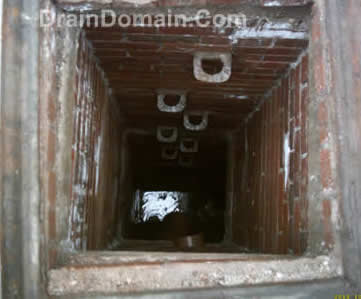 An integral part of any drainage system are the access points into it when it comes to cleaning, clearing and inspection, however the number and construction of any chambers at your property, if any will be largely dependant on its age.
An integral part of any drainage system are the access points into it when it comes to cleaning, clearing and inspection, however the number and construction of any chambers at your property, if any will be largely dependant on its age. 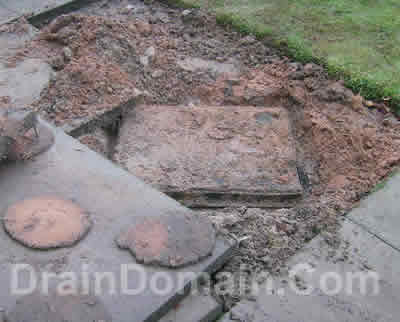 Firstly if you have a look at neighbouring properties of a similar construction to yours they are often a mirror image, if they have a chamber on the front boundary line or adjacent the the soil vent pipe then chances are yours will too especially If this is echoed on two or more houses and the covers seem original to the style of the property.
Firstly if you have a look at neighbouring properties of a similar construction to yours they are often a mirror image, if they have a chamber on the front boundary line or adjacent the the soil vent pipe then chances are yours will too especially If this is echoed on two or more houses and the covers seem original to the style of the property. 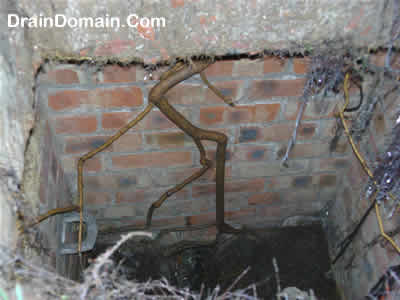 The majority of chambers were brick built with some of the larger chambers on sewer systems being works of art with corbled and stepped courses used to reduce the chamber size at ground level and arched sections used instead of reducing slabs, we find very old circular brick built chambers occasionally without any mortar being used above the channel pipe levels.
The majority of chambers were brick built with some of the larger chambers on sewer systems being works of art with corbled and stepped courses used to reduce the chamber size at ground level and arched sections used instead of reducing slabs, we find very old circular brick built chambers occasionally without any mortar being used above the channel pipe levels. 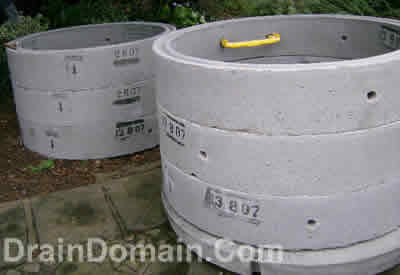 Concrete section manholes have been around for many years and are produced for the domestic market as well as large sewer systems, rectangle sections as small as 600x450x150mm (length x width x depth) can be easily carried by one person, by the time you get to the 600x450x300 then you will be looking for a mate to help you out.
Concrete section manholes have been around for many years and are produced for the domestic market as well as large sewer systems, rectangle sections as small as 600x450x150mm (length x width x depth) can be easily carried by one person, by the time you get to the 600x450x300 then you will be looking for a mate to help you out.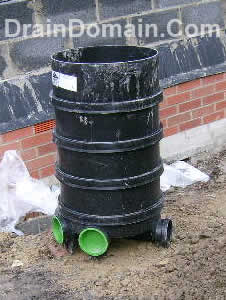 Preformed plastic manholes make the construction of a domestic chamber very simple, they come in three components the manhole base, the riser pieces (manhole rings) and the cover and frame.
Preformed plastic manholes make the construction of a domestic chamber very simple, they come in three components the manhole base, the riser pieces (manhole rings) and the cover and frame. 
